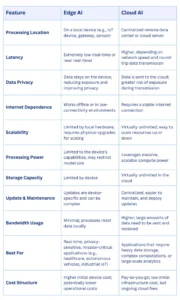Are you planning to integrate AI in your business? If yes, you need to understand the differences and basic knowledge about AI terms. When it comes to Edge AI vs Cloud AI, there’s no one best approach among them. What works best for your business depends on your specific requirements. In this blog, we shall explore Edge artificial intelligence, cloud AI models, and the key points of difference between the two. Once you understand the difference between these two approaches, you can consider and choose one that suits your organizational requirements the best.
Edge AI vs Cloud AI
The basic distinction between edge AI vs cloud AI is the location of data processing. Edge artificial intelligence’s data processing happens on the same device where the data is generated. On the other hand, Cloud AI sends data to a remote server for processing. Edge AI is named so because it analyzes data closer to its source, thus the “ on the edge” reference. Differing from it, Cloud AI models operate applications in private data centers or clouds. Both these approaches have their unique pros and cons. For businesses, the best choice depends on their computing power, response time, bandwidth, and security requirements.
What is Edge Artificial Intelligence?
Edge artificial intelligence, also known as “ AI on the edge” or “on-device AI”, uses a mix of edge computing with artificial intelligence to allow real-time data processing and analysis at the point of interaction. This data processing can happen on a computer, edge server, or any IoT device (Internet of Things). Such devices include smart watches, smartphones, or smart home devices like thermostats.
Edge computing ensures data processing, storage, and analysis closer to its source. With AI systems like predictive analytics, voice and image recognition, or anomaly detection, data processing and response generation happen directly on the network edge. Thus, providing real-time feedback on their specific programming parameters. Edge AI removes the requirement of sending data to a remote server for processing, thus it results in faster responses, less latency, and better security.
What Is Edge AI Used For?
Edge artificial intelligence is used in smart devices like smartphones, watches, and other appliances. Apart from this, virtual assistants like Siri, Alexa, and Google Assistant, real-time traffic updates, and autonomous vehicles use Edge AI. It is used in various industries like healthcare, manufacturing, retail, smart homes and smart cities, security and surveillance, etc. Let us see how Edge artificial intelligence is used in these industries.
-
Healthcare
Edge AI improves patients’ experience as it reduces diagnosis and treatment times. It also allows real-time patient supervision through IoT devices. Its fast response and data processing make the exchange of information between health care professionals swift, essential during an emergency. Thus, artificial intelligence in healthcare is a blessing for society.
-
Manufacturing
Edge artificial intelligence enhances operations in processes like quality control, worker safety, and supply chain analytics. On-device AI-powered sensors facilitate predictive maintenance, threat detection, and alerting staff proactively.
-
Retail
Edge AI can help physical stores become competitive with e-commerce platforms by empowering them with smart shopping carts and checkouts. AI in retail industry allows businesses to process customer data in real time, helping to offer better customer experience, reducing inventory loss, and maintaining optimum inventory levels.
-
Security
Smart security devices utilize AI’s computer vision and object detection abilities to actively inform users of probable issues. Thus, it allows real-time image and video analysis. It can also identify abnormal banking activity, helping provide timely information about suspicious transactions.
-
Smart Homes and Cities
Smart home devices like doorbells, thermostats, and fridges utilize Edge AI to process data on the device, monitor heating, cooling, lighting, face detection, motion detection, and provide alerts. Cities also use Edge artificial intelligence for traffic pattern analysis and managing parking.
Challenges and Benefits of Edge AI
The major benefits of edge AI include lower latency, lower bandwidth usage, real-time data processing, improved data privacy, lower costs, and faster response time. Offline abilities and lower costs make Edge AI an easily accessible option. This technology approach helps businesses automate processes, enhance decision-making, and offer a more sustainable AI option due to local, low-power data processing. On the downside, Edge artificial intelligence requires higher computing power. The storage capacity of edge AI is another drawback to consider before choosing it. The storage potential of your AI is limited to the edge device.
What is Cloud AI?
Cloud AI models, also called AI as a service (AIaaS), are the models that run on remote servers, hosted by cloud providers like Google Cloud, AWS, or Microsoft Azure. It integrates AI with cloud computing to provide organizations with access to large data sets and more computing power. Moreover, they don’t even need to rely on costly, on-premises infrastructure for such an approach. It requires fewer databases, software, facilities, and hardware.
Such cloud computing offers AI with the infrastructure and computational power to process complex tasks like image recognition, Natural Language Processing (NLP), and data analytics. This collaboration offers organizations the opportunity to improve their operations through data-based decisions and strategic automation, resulting in streamlined processes and an increase in efficiency.
Features of Cloud AI
Below are the important features of cloud AI models, you should consider before AI adoption in your business.
- Centralized Storage and Processing
- Scability
- Computational Power
- Remote Accessibility
Use Cases of Cloud AI Models
Some of the popular applications of Cloud AI models are chatbots, business intelligence, IoT, and generative AI. It is a suitable approach for industries that depend on large datasets, such as e-commerce, banking, and healthcare. Let us see how these industries utilize Cloud AI for their operations.
-
Health Care
Cloud AI is supportive of modern health care initiatives, like drug discovery, patient data management, diagnosis, and prognosis. Cloud AI in healthcare streamlines treatment development by analyzing biomedical data and optimizing clinical trials with patient history.
-
Retail
With the immense computing power of Cloud AI, businesses can forecast trends, optimize operations, and make more informed, data-based decisions. Its machine learning abilities and predictive analytics allow Cloud AI to offer custom advice to customer queries, personalized product recommendations, and automate inventory management. Thus, it offers enhanced customer satisfaction and reduces costs.
-
Finance
Cloud AI has exceptional capabilities for fraud detection and risk management. That is due to its training to detect unusual patterns and anomalies in large data sets. These capabilities come in handy in the finance industry for threat prevention and risk mitigation.
Challenges and Benefits of Cloud AI
Cloud AI models are scalable, accessible, have processing power, and potentially cost-saving. These benefits of Cloud AI make it appealing for businesses. Cloud AI models are easier to upgrade than edge AI, with timely updates. As cloud AI isn’t dependent on specific hardware, its processing capacity can be adjusted as required. So, it is beneficial for organizations that are subject to workload fluctuation. Cloud AI offers application programming interfaces (APIs) for the smooth integration of AI with existing systems. On the downside, concerns about latency, connectivity, integration, and data privacy remain with the Cloud AI approach. Cloud AI’s dependency on remote data centers can result in increased latency and bandwidth concerns. Sensitive data transfer also raises privacy concerns because cloud AI models need an internet connection, which might not be safe.
Edge AI vs Cloud AI- What Are the Key Differences
The key differences between edge AI vs cloud AI include speed, latency, privacy, computational power, network reliability, and scalability. With both approaches having their specific purpose, it should be noted that they are not mutually exclusive; they are deeply connected. A combination of these two approaches can also exist in some cases, depending on the application. For business applications, all the pros and cons of both approaches should be considered to check what aligns with your organization’s requirements. Let us now see the key differences between edge AI and cloud AI models.

Conclusion
Both edge AI and cloud AI have their specific pros and cons. If you are a business owner, you can choose either of these approaches, or a combination of both, depending on your overall requirement. If your business is small and scalable, opting for cloud AI models would be the best. This is because your AI system can then grow with your business, update with time, and integrate multiple applications as your requirements change. AnavClouds Analytics.ai is a reliable AI development company you can count on for a custom AI tool that suits your needs. With detailed consultation sessions, ongoing support, and post-deployment services, we provide exceptional AI development services for your business. Book a demo today and explore more information about AI in business operations.
FAQs
What is the difference between cloud AI and edge AI?
Edge artificial intelligence processes data on the same device where it is generated, while Cloud AI sends the data to a remote server or cloud for processing. This is the main difference between cloud AI and edge AI.
Is edge computing better than cloud computing?
None of the two is better than the other; rather, they have different sets of pros and cons. Edge computing requires less bandwidth than cloud computing, but cloud computing has adjustable computational capacities that edge computing lacks.
Is AWS or Google Cloud better?
Both Google Cloud and AWS offer a variety of features of computational power. However, developers who want better control of their computation prefer AWS for its higher raw compute power.
Is cloud computing high-paying?
Considering the current scenario, cloud computing is certainly going to be a rewarding field. For people planning to be cloud engineers, it is surely a good time to give it a go.
Can edge computing work without the internet?
Edge computing does not necessarily need the internet to function. It is designed to process data locally on the device itself.



